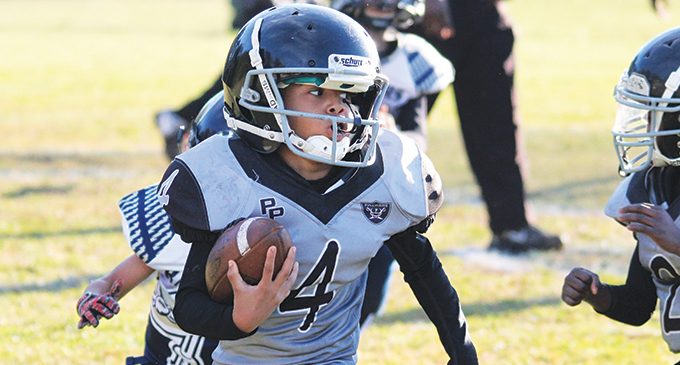Head impacts in youth football increase
Photo by Timothy Ramsey

Recently Wake Forest Baptist Medical Center conducted a study on the number of head impacts in youth football players as they move up in age and weight-based levels of play. Head injuries have been a big topic in football on all levels, which has been a cause for concern for some parents, while other parents have less worries.
The Wake Forest Baptist study employed in-helmet sensors to record head impacts in youth football players. They collected the number and location of impacts and the linear and rotational acceleration they caused to the heads of 97 players, ages 9 to 13 in one youth football organization.
They recorded more than 40,000 head impacts, which is the largest collection of biomechanical head impact data for youth football to date, according to study author Jillian Urban, Ph.D. The study shows a trend of head impact exposure increasing with increasing level of play, but with variability within levels of play.
The researchers also found that while approximately two-thirds of all head impacts in the study occurred during practice, the percentage of high magnitude impacts was higher in games and the number of such impacts in games increased with the level of play.
The parents on both sides of the equation have very strong convictions about letting their children play football at such an early age. Julius Reese is a former Division I football player from the University of North Carolina at Chapel Hill and he will not allow his son to play football because of the injuries he sustained while playing.
“Me, being a former football player, I can’t see any future in the way they treat youth athletes as they progress in youth football,” said Reese. “There are a lot of rules, stipulations and equipment in place now for football that is not protecting the players; it’s protecting owners against lawsuits.
“There is nothing that I see that protects the players and there is no longevity in that sport,” he continued. “Many times the coaching aspect at the Pop Warner level is not up to par, and when you have these inexperienced coaches out here teaching kids, it can lead to a lot of injuries.”
For Reese, he says he sometimes gets headaches and memory loss at times that he thinks is attributed to his time playing the sport. He felt as though kids should not be playing contact football until the age of fourteen because of the potential head injuries that can take place in a developing brain of an adolescent youth.
Reese feels one of the biggest problems on the Pop Warner level is the inexperienced coaches. He says many of these coaches have never played the game and sometimes teach the wrong techniques to the players.
Chronicle Publisher James Taylor is also a former collegiate football player at North Carolina Central University. He has made the decision to not allow his children to play the sport as well. He feels there is so much evidence that supports the dangers of head trauma for a young person playing the game.
With him being a former football player, he knows the bumps and bruises that can occur while playing the game. As far as Taylor is concerned, he would rather have his sons play a non-contact sport that does not put his children in jeopardy of long-term adverse affects from playing the sport.
“I would really love to see the grades and test scores of the kids that have not played contact sports versus those who did because I can guarantee you that you will probably find that those who take hits to the head make lower scores and grades collectively than their counterparts who do not,” said Taylor. “I am not letting my kids play, period.”
There are also parents who have let their kids play the sport at a young age but changed their minds once a head injury did occur.
Antwan Steele Sr. says he let his son play contact football until he sustained a concussion at the age of seven. He said after seeing the his son deal with the symptoms of a concussion he is worried about it happening again along with the long-term effects it can cause.
According to Steele, his son slammed his head against the ground while playing and sustained his concussion. Following a conversation with his wife, they decided to not let his son play contact football until he reaches the high school level. While his son excels at other sports such as basketball and soccer, contact football is out of the question until high school.
Steele feels that the added certifications and training the youth coaches are receiving can do nothing but help make the sport safer. He says that he did not have this way of thinking prior to his son’s concussion but once he had the chance to see what could happen it opened his eyes to the dangers of the sport on a young brain.
On the other side of the equation, there are parents who do not have the same level of concern about their kids playing the sport at a young age. Barry Gwyn is a parent who also coaches his son with the Kernersville Raiders. He says he acknowledges the fact there is a chance of head injuries but is confident in the coaching his son receives along with the equipment improvements over the years.
“One of the things I believe in is the coaching because we have to take classes now to study the game,” said Gwyn. “I trust the coaches to teach the kids the proper way to tackle and things of that nature. I put the trust in us to do the right thing, so that’s why I don’t have any concerns about it.
“At first it wasn’t an agreement with my wife but I made an executive decision,” Gwyn continued. “I just explained to her that my job out here is to be a father and a coach and she agreed.”
Gwyn says if a head injury does occur to his son he will have some concerns because of all the new information that has come to light about the subject. He says he started playing football at the age of seven and played throughout high school but doesn’t know if that has given him any lingering affects.
Bennie Oates, head coach for the Kernersville Raiders Tiny Mite team, says he has been coaching little league football for 16 years and has not seen a dip in participation from the younger kids in recent years. He thinks as the kids get older they become more aware of the dangers and some have gravitated to other sports.
“Nowadays you have to make sure that you prepare them correctly by teaching them the right way to play,” he said. “My concerns have dropped since watching him grow and doing it the right way. The biggest thing is knowledge and knowing what to see and how to prevent it.”
Alphonso Abbott Jr. says his son has been playing contact football since the age of five. He does not have any concerns about his son because of the way he plays the game. He knows there is a possibility that it could happen but is confident in the improvements manufactures have made in equipment.
Abbott says if his son were to sustain a concussion he would wait the appropriate time for recovery and allow his son to let him know if he wanted to continue to play. He says his son’s love of the sport runs deep and he would not take that away from him.
With all the talk about head impacts on players in the sport, it is natural to assume that it would affect the higher levels of football. Rod Dunlap, varsity coach at Reynolds High, thinks with all of the recent studies that have come out about head impacts, that it has affected the number of kids coming out to play the sport.
“I have noticed a drop in kids coming out and deciding to opt out and go to different sports,” said Dunlap. “I think it’s due to parent involvement because they are concerned for the welfare of their kids.”
Dunlap, a former collegiate player himself, says he does not have any symptoms from playing football. He said he would allow his son to play if he chose to do so. He feels if you teach the kids the correct way to play, it dramatically decreases the chances for injury.
Our results are consistent with prior studies of high school and college athletes showing that head impact exposure increases with increasing age and level of play,” Urban said. “But they also show differences from one level to the next in a single youth organization.”
“Further studies that take into consideration the various levels of youth football could guide evidence based intervention efforts, such as changes in practice structure and game rules, to reduce the number of high magnitude impacts, impact frequency and the total number of impacts with the ultimate goal of improving safety in youth football.”















